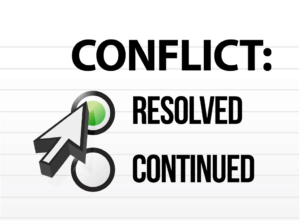 by Jon Anderson
by Jon Anderson
As with almost all interactions between humans, power will always be an issue. No one wants to be overpowered; it’s an instinct to protect ourselves and those we feel responsible for from harm. That doesn’t mean there will always be a struggle for power in every situation. However, in cases of conflict resolution, it has already reached the point of a power struggle.
 Once in power struggle mode, each party will eventually gravitate to one of two power camps. One camp will assert itself in the overt power position, the camp that has more visible strength. That strength can take many forms: physical strength, strength in numbers, strength in a higher position within a hierarchy, or strength of will.
Once in power struggle mode, each party will eventually gravitate to one of two power camps. One camp will assert itself in the overt power position, the camp that has more visible strength. That strength can take many forms: physical strength, strength in numbers, strength in a higher position within a hierarchy, or strength of will.
Once the overt camp has claimed that position, the other camp will normally drift or even quickly shift into the covert position. Like the term implies, the covert position doesn’t seem as powerful and may even pretend to go along with much or all of what the overt camp is demanding. But, make no mistake, if there is not enough mutual understanding and an agreeable compromise, the covert camp will not be left powerless. It can even become more powerful than the overt camp by sabotaging the new plan.
It is usually helpful to explain to the parties in conflict that you realize they each have an idea of how to best move forward, and those ideas conflict. Therefore, neither idea is likely to work out in the long run.. Instead, all parties will be required to work together to come up with a new idea that meets the concerns of the majority.
When dealing with a conflict, as soon as you can recognize which party is in the covert camp, it is important to have them express their concerns to the other party. In this phase, you, as the arbiter, must make it clear that they are not to present their arguments here. They’ve most likely already done that. Instead, have them express their concerns to the overt party. What outcomes do they want? What are their fears about the outcomes? At the same time, the overt party should be directed to only listen, without interrupting, to understand those concerns, not to answer them or build a case against them. It is usually best to give the covert camp a specific amount of time to voice those concerns; five minutes is typically ample. Keeping a timer helps each camp to feel like they are going to get a fair and equal amount of time.
Once time is up for the covert camp, it is now time to direct the overt camp to reflect back what they believe the covert side was saying. You can actually tell the overt side to tell the covert side what they heard were their concerns. You should also direct them not to refute any of these concerns, but to only acknowledge that they understand the concerns of the other party.
Next, give the covert camp a chance to clarify anything they think the overt camp didn’t understand. Then, have the overt camp reflect back on what they heard in that clarification. Throughout this process, you must direct each camp to face and speak to the other when they are talking. This helps them to see you as a true arbiter, concerned for the best interests of both sides, rather than a judge or juror.
Once it appears that the covert side feels relatively understood, you now repeat this process for the overt camp. Express your concerns, followed by the covert side reflecting their understanding of those concerns. Clarify if needed, then reflect the understanding.
Once both sides feel that their concerns are mutually understood, they will now, most likely, want to provide reasons and/or data to back up their points of view. Here’s where it’s important to help them understand that more evidence is not going to help the other side understand them. Instead, more evidence will only push the other side to come up with more evidence for their own perspective. Now is when you introduce the strategy of “Both Win.” Instead of one side ending up feeling like they’ve won, and the other feeling like they lost out, both sides are going to brainstorm new solutions that could possibly create a win/win situation. Write these down as people come up with them. In a brainstorming session, there are no bad ideas, so write them all down without comment. You should also remind them that the solutions they have proposed in the past are not going to work. So, they may as well keep those to themselves.
After all the ideas have been expressed, you can have them each submit a secret ballot listing their top three choices. After you have tallied up the ballots, present them with the top three choices and direct them to, together, decide which one best meets the rule of both win.
This template has a very high success rate with couples I’ve worked with over the years. And, I’ve had great success using it with some churches and organizations. However, it doesn’t work with all situations. Sometimes cases have become too toxic for even the most skilled of arbiters. That’s where we at Hope Network Ministries can come in. We have partners who have successfully helped hundreds of conflict cases over the years.
Note: If it is the case that the covert party was the one that had you brought in to be the arbiter, flip this script and have the overt camp express their concerns first. In these cases, the overt party might feel like they have less power.
True reconciliation happens when understanding replaces defensiveness and when both sides seek the good of one another. This model reminds us that conflict can become a sacred opportunity to listen, to learn, and to reflect the heart of Christ in how we respond. While some situations may require outside help, this approach invites us to trust that healing is possible when humility, patience, and honest dialogue guide the way.
Jon R Anderson
email: jon@GrowingLoveNetwork.org
About the Author
Jon earned his Master’s degree, in Marriage and Family Therapy, from Abilene Christian University. Jon’s passion is to promote healthy marriage and to equip churches to minister effectively to marriages. He founded Growing Love Network and has worked with thousands of couples and individuals through counseling and therapy. Through GLN, he and his wife, Joanna, have led more than 160 workshops around the nation for struggling marriages, Love Reboot. In addition, Jon has worked with numerous churches to help them develop more effective marriage ministries, and conducting his marriage retreat, My Love Lasts.
He has trained more than 200 couples to lead marriage courses and has developed a curriculum – Growing Love – which is useful in various settings such as: bible classes, home studies, as a mentoring tool and with a counselor or therapist. He is also the author of The Acceptance: What Brings and Keeps Lifelong Love, and 365 Days of Growing Love.

Leave a Reply